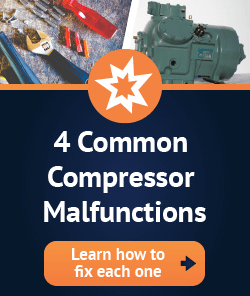Commercial HVAC/R systems are the backbone of maintaining a comfortable and productive environment in any commercial building. The compressor, often called the heart of the HVAC/R system, plays a crucial role in regulating temperature and ensuring efficient operation. However, a malfunctioning compressor can lead to significant issues. Identifying if your commercial HVAC/R compressor has a problem is vital to prevent further damage to the HVAC/R system and avoid costly repairs. Here are key signs and diagnostic steps to determine if your compressor is the culprit behind power surges.
1. Frequent Tripping of Circuit Breakers
One of the most obvious signs that your compressor might be experiencing an electrical problem is the frequent tripping of circuit breakers. Circuit breakers are designed to protect your electrical system by shutting off the power when they detect an overload. If your HVAC/R system’s circuit breaker trips regularly, it could indicate that the compressor is drawing too much power. This can happen due to internal issues within the compressor, such as worn-out components or electrical faults.
2. Unusual Noises During Operation
Another telltale sign of a problematic compressor is unusual noises during operation. A healthy compressor should run relatively quietly, with a consistent hum. If you notice loud banging, clanking, or hissing sounds, it could indicate that the compressor is struggling to operate efficiently. These noises can result from mechanical failures that need to be addressed as quickly as possible by an authorized technician.
3. Diminished Cooling or Heating Performance
If your commercial HVAC/R system is not cooling or heating as effectively as it should, the compressor might be to blame. A failing compressor can struggle to maintain the desired temperature, leading to fluctuations and inadequate performance. This inefficiency can cause the system to overwork, drawing excessive power.
4. High Energy Bills
A sudden spike in energy bills can be a clear indicator of an overworking HVAC/R system. If your energy costs have increased significantly without a corresponding increase in usage, it could be due to a compressor that is starting to malfunction. When the compressor is not operating efficiently, it consumes more power to try and maintain the required temperature, resulting in higher energy consumption and increased costs.
5. Visible Damage or Wear and Tear
Performing a visual inspection of the compressor can also help identify potential issues. Look for signs of physical damage, such as frayed wires, burnt components, or oil leaks. These can indicate internal problems within the compressor that may cause power surges. Regular maintenance and inspections are essential to catch these issues early and prevent them from escalating.
Diagnostic Steps to Confirm Electric Issues with Your Compressor
If you suspect that your commercial compressor is having electrical problems, it’s essential to conduct a thorough diagnostic process to confirm and address the issue. Here are some steps to follow:
- Check the Electrical Connections: Inspect all electrical connections to ensure they are secure and corrosion-free. Loose or damaged connections can lead to electrical faults and contribute to power surges.
- Measure the Current Draw: Use an ammeter to measure the compressor’s current draw during operation. Compare the readings with the manufacturer’s specifications. An abnormally high current draw can indicate that the compressor is overloading the electrical system.
- Inspect the Capacitors: Capacitors play a crucial role in the compressor’s operation by providing the necessary start and run power. Test the capacitors for proper functionality and replace any that show signs of wear or failure.
- Evaluate the Start Relay: The start relay is responsible for energizing the start winding of the compressor motor. A faulty start relay can prevent the compressor from starting correctly, leading to repeated attempts and potentially causing more harm.
- Check for Refrigerant Issues: Low refrigerant levels can cause the compressor to overheat and draw excessive power. Ensure that the refrigerant levels are within the recommended range and inspect for any leaks that must be addressed.
- Monitor for Short Cycling: Short cycling, where the compressor frequently turns on and off, can indicate underlying issues. This behavior increases wear and tear on the compressor and can lead to additional problems. Identify and rectify the cause of short cycling, which could be due to thermostat problems, refrigerant issues, or electrical faults.
Time To Order a Remanufactured Commercial HVAC Compressor
Recognizing the signs of a malfunctioning compressor and understanding how to diagnose potential problems are critical skills for commercial HVAC/R technicians. By staying vigilant and performing regular maintenance, you can ensure the longevity and efficiency of the HVAC/R system, ultimately providing a comfortable environment for building occupants. If you suspect that your compressor is starting to have a problem, taking prompt action to diagnose and repair the issue can prevent further damage and save on costly repairs. Remember, a well-maintained HVAC/R system is key to a successful commercial operation.
If your commercial HVAC compressor is beyond repair, look for a remanufactured commercial HVAC compressor as a solid replacement.












